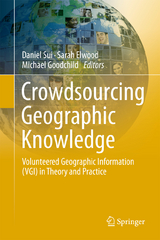Crowdsourcing Geographic Knowledge
Chapter 1: VGI, the exaflood, and the growing digital divide: Daniel Sui, Michael Goodchild, & Sarah Elwood.- Section I. Public Participation and Citizen Science.- Chapter 2: Understanding the value of VGI: Rob Feick & Stéphane Roche.- Chapter 3: To volunteer or to contribute locational information? Towards truth in labeling for crowd-sourced geographic information: Francis Harvey.- Chapter 4: Metadata squared: Enhancing its usability for volunteered geographic information and the GeoWeb: Barbara Poore & Eric Wolf.- Chapter 5: Situating the adoption of VGI by government: Peter Johnson & Renee Sieber.- Chapter 6: When Web 2.0 meets public participation GIS (PPGIS): VGI and spaces of participatory mapping in China: Wen Lin.- Chapter 7: Citizen science and volunteered geographic information: Overview and typology of participation: Muki Haklay.- Section II. Geographic Knowledge Production and Place Inference.- Chapter 8: Volunteered geographic information and computational geography: New perspectives: Bin Jiang.- Chapter 9: The evolution of geo-crowdsourcing: Bringing volunteered geographic information to the third dimension: Marcus Goetz & Alexander Zipf: Chapter 10: From volunteered geographic information to volunteered geographic services:Jim Thatcher.- Chapter 11: The geographic nature of Wikipedia authorship.- Darren Hardy.- Chapter 12: Inferring thematic places from spatially referenced natural language observations: Benjamin Adams & Grant McKenzie.- Chapter 13: “I don't come from anywhere:" Exploring the role of VGI and the Geoweb in rediscovering a sense of place in a dispersed Aboriginal community: Jon Corbett.- Section III. Emerging Applications and New Challenges.- Chapter 14: Potential contributions and challenges of VGI for conventional topographic base-mapping programs: David Coleman.- Chapter 15: “We know who you are and we know where you live:”A research agenda for web demographics: T. Edwin Chow.- Chapter 16: Volunteered geographic information, actor-network theory, and severe storm reports: Mark Palmer & Scott Kraushaar.- Chapter 17: VGI as a compilation tool for navigation map databases: Michael Dobson.- Chapter 18: VGI and public health: Possibilities and pitfalls: Christopher Goranson, Sayone Thihalolipavan, & Nicolás di Tada.- Chapter 19: VGI in education: From K-12 to graduate studies: Thomas Bartoschek & Carsten Keßler.- Chapter 20: The prospects VGI research and the emerging fourth paradigm: Sarah Elwood, Michael Goodchild, & Daniel Sui.
| Erscheint lt. Verlag | 8.8.2012 |
|---|---|
| Zusatzinfo | XII, 396 p. |
| Verlagsort | Dordrecht |
| Sprache | englisch |
| Maße | 155 x 235 mm |
| Themenwelt | Informatik ► Datenbanken ► Data Warehouse / Data Mining |
| Informatik ► Theorie / Studium ► Künstliche Intelligenz / Robotik | |
| Naturwissenschaften ► Geowissenschaften ► Geografie / Kartografie | |
| ISBN-10 | 94-007-4586-9 / 9400745869 |
| ISBN-13 | 978-94-007-4586-5 / 9789400745865 |
| Zustand | Neuware |
| Haben Sie eine Frage zum Produkt? |
aus dem Bereich




